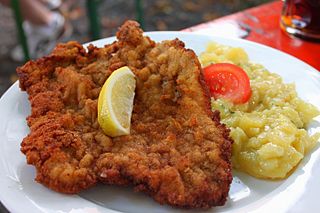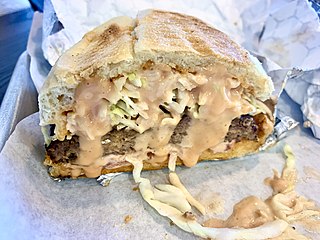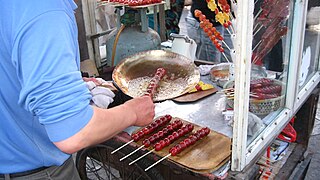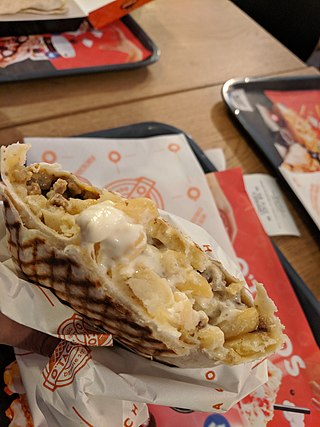
Argentine cuisine is described as a blending of cultures, from the Indigenous peoples of Argentina who focused on ingredients such as humita, potatoes, cassava, peppers, tomatoes, beans, and yerba mate, to Mediterranean influences brought by the Spanish during the colonial period. This was complemented by the significant influx of Italian and Spanish immigrants to Argentina during the 19th and 20th centuries, who incorporated plenty of their food customs and dishes such as pizzas, pasta and Spanish tortillas.

An empanada is a type of baked or fried turnover consisting of pastry and filling, common in Spain, other Southern European countries, North African countries, Latin American countries, and the Philippines. The name comes from the Spanish empanar, and translates as 'breaded', that is, wrapped or coated in bread. They are made by folding dough over a filling, which may consist of meat, cheese, tomato, corn, or other ingredients, and then cooking the resulting turnover, either by baking or frying.

Calzone is an Italian oven-baked turnover, made with leavened dough. It originated in Naples in the 18th century. A typical calzone is made from salted bread dough, baked in an oven and stuffed with prosciutto or salami, mozzarella or ricotta, and Parmesan or pecorino, as well as an egg. Different regional variations in or on a calzone can often include other ingredients that are normally associated with pizza toppings. The term usually applies to an oven-baked turnover rather than a fried pastry, although calzones and panzerotti are often mistaken for each other.

Schnitzel is a thin slice of meat. The meat is usually thinned by pounding with a meat tenderizer. Most commonly, the meat is breaded before frying. Breaded schnitzel is popular in many countries and is made using veal, pork, chicken, mutton, beef, or turkey. Schnitzel originated as wiener schnitzel and is very similar to other breaded meat dishes.

The cuisine of Philadelphia was shaped largely by the city's mixture of ethnicities, available foodstuffs and history. Certain foods have become associated with the city.

Picadillo is a traditional dish in many Latin American countries including Mexico and Cuba, as well as the Philippines. It is made with ground meat, tomatoes, and also raisins, olives, and other ingredients that vary by region. The name comes from the Spanish word picar, meaning "to mince".

Cuchifritos or cochifritos refers to various fried foods prepared principally of pork in Spanish and Puerto Rican cuisine. In Spain, cuchifritos are a typical dish from Segovia in Castile. The dish consists of pork meat fried in olive oil and garlic and served hot. In Puerto Rico they include a variety of dishes including morcilla, rellenos de papa, and chicharron, and other parts of the pig prepared in different ways. Some cuchifritos dishes are prepared using cooking plantain as a primary ingredient. Cuchifritos vendors also typically serve juices and drinks such as passionfruit, pineapple, and coconut juice, as well as ajonjolí, a drink made from sesame seeds.

Dominican cuisine is made up of Spanish, Indigenous Taíno, Middle Eastern, and African influences. The most recent influences in Dominican cuisine are from the British West Indies and China.

The cuisine of New Jersey is derived from the state's long immigrant history and its close proximity to both New York City and Philadelphia. Due to its geographical location, New Jersey can generally be divided by New York City cuisine in the northern and central parts of the state and Philadelphia cuisine in the southern parts. Restaurants in the state often make use of locally grown ingredients such as asparagus, blueberries, cranberries, tomatoes, corn, and peaches. New Jersey is particularly known for its diners, of which there are approximately 525, the most of any state. Various foods invented in the state, such as the pork roll, and salt water taffy, remain popular there today.

Uruguayan cuisine is a fusion of cuisines from several European countries, especially of Mediterranean foods from Spain, Italy, Portugal and France. Other influences on the cuisine resulted from immigration from countries such as Germany and Scotland. Uruguayan gastronomy is a result of immigration, rather than local Amerindian cuisine, because of late-19th and early 20th century immigration waves of, mostly, Italians. Spanish influences are abundant: desserts like churros, flan, ensaimadas yoo (Catalan sweet bread), and alfajores were all brought from Spain. There are also various kinds of stews known as guisos or estofados, arroces, and fabada. All of the guisos and traditional pucheros (stews) are also of Spanish origin. Uruguayan preparations of fish, such as dried salt cod (bacalao), calamari, and octopus, originate from the Basque and Galician regions, and also Portugal. Due to its strong Italian tradition, all of the famous Italian pasta dishes are present in Uruguay including ravioli, lasagne, tortellini, fettuccine, and the traditional gnocchi. Although the pasta can be served with many sauces, there is one special sauce that was created by Uruguayans. Caruso sauce is a pasta sauce made from double cream, meat, onions, ham and mushrooms. It is very popular with sorrentinos and agnolotti. Additionally, there is Germanic influence in Uruguayan cuisine as well, particularly in sweet dishes. The pastries known as bizcochos are Germanic in origin: croissants, known as medialunas, are the most popular of these, and can be found in two varieties: butter- and lard-based. Also German in origin are the Berlinese known as bolas de fraile, and the rolls called piononos. The Biscochos were re-christened with local names given the difficult German phonology, and usually Uruguayanized by the addition of a dulce de leche filling. Even dishes like chucrut (sauerkraut) have also made it into mainstream Uruguayan dishes.
Pastel is the Spanish and Portuguese word for pastry, a sugary food, and is the name given to different typical dishes of various countries where those languages are spoken. In Mexico, pastel typically means cake, as with Pastel de tres leches. However, in different Latin American countries pastel can refer to very different sugary dishes, and even to non-sugary ones as well. In some places, like Brazil, a pastel can refer to both a sugary and non-sugary food, depending on the filling used.

Mexican street food, called antojitos, is prepared by street vendors and at small traditional markets in Mexico. Street foods include tacos, tamales, gorditas, quesadillas, empalmes, tostadas, chalupa, elote, tlayudas, cemita, pambazo, empanada, nachos, chilaquiles, fajitas, tortas, even hamburgers and hot dogs, as well as fresh fruits, vegetables, beverages and soups such as menudo, pozole and pancita. Most are available in the morning and the evening, as mid-afternoon is the time for the main formal meal of the day. Mexico has one of the most extensive street food cultures in Latin America, and Forbes named Mexico City as one of the foremost cities in the world in which to eat on the street.

A great variety of cassava-based dishes are consumed in the regions where cassava is cultivated. Manihot esculenta is a woody shrub of the spurge family, Euphorbiaceae, native to South America, from Brazil, Paraguay and parts of the Andes.

A croquette is a deep-fried roll originating in French cuisine, consisting of a thick binder combined with a filling, which is then breaded. It is served as a side dish, a snack, or fast food worldwide.

Regional street food is street food that has commonalities within a region or culture.

Breaded cutlet or braised cutlet is a dish made from coating a cutlet of meat with breading or batter and either frying or baking it.

A French tacos, Lyonese tacos or matelas, is a fast food dish which usually consists of a flour tortilla grilled and folded around a filling of French fries, cheese, and meat, among other deli ingredients.

Loaded fries is a dish consisting of French fries topped with a combination of cheese, sauces, meat, and vegetables.
















